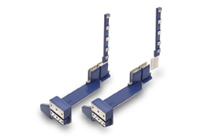Bus Bar Solution for Misalignment in Scalable Server System
CHALLENGE
 Methode worked with the customer’s engineers to optimize a scalable design for increasing the capacity of a high-end server where the system operates at a very low DC voltage.
Methode worked with the customer’s engineers to optimize a scalable design for increasing the capacity of a high-end server where the system operates at a very low DC voltage.
SOLUTION
After collaborating with the customer’s engineers to optimize a design, Methode developed a high-current louver contact with silver plating for durability over multiple insertions and low voltage drop, solving the customer’s problem and reducing cost.
STORY
The customer desired a scalable design that would allow them to add modules to increase the power capacity of their high-end server. In addition, the system distribution voltage was very low, requiring a bus bar with minimal voltage drop. Because of tolerance buildup when the bus bars were mounted in the cabinet, some float in the connection was required to ensure the blade bus bar aligned perfectly with the mating receptacle. Both the blade and receptacle bus bars had to be insulated from other nearby metal parts in the computer cabinet.
Methode engineers met on a regular basis with the customer’s engineers to design a high-current louver contact system that had some float and allowed for misalignment between the blade and receptacle bus bars due to tolerance buildups in the cabinet. The blade bus bars were designed with a lead-in chamfer to facilitate their engagement within the louver contacts. Dovetailed slots were machined into the copper receptacle bus bars to hold the louver contacts securely in place. Silver plating was chosen because of its durability over multiple insertions and low voltage drop.
Powder coating was selected as the insulation of choice for both the blade and receptacle bus bars. It easily met the 500 VDC dielectric requirements, and provided durability. Portions of the copper receptacle bus bar were extruded to reduce cost and minimize machining time.
